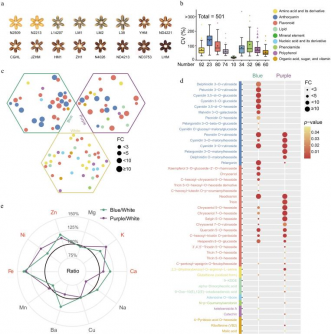
URGENT UPDATE: New research has just unveiled that colored wheat varieties contain a staggering 501 essential nutrients, offering a promising path to enhance global nutrition. Researchers from Huazhong Agricultural University, led by Wei Chen, confirmed that colored wheat—characterized by its striking blue, purple, and black grains—boasts significantly higher levels of anthocyanins, flavonoids, vitamins, and essential minerals like zinc and iron compared to traditional white wheat.
This groundbreaking study, published on March 7, 2025, in the journal Seed Biology, highlights the urgent need for improved nutritional content in staple crops. As global dietary trends shift toward “eating well,” the health benefits of colored wheat could play a critical role in addressing the persistent issue of “hidden hunger” affecting millions worldwide.
Researchers employed advanced ionomic and metabolomic profiling techniques to analyze grains from various wheat types. They found that during the mid-filling phase, particularly “green wheat kernels,” these grains were exceptionally nutrient-rich, possessing over 200 nutrients more than their mature counterparts. The study revealed that anthocyanin levels increased significantly during the early stages of grain development, peaking mid-filling before declining as the grains matured.
The findings are crucial not only for agricultural practices but also for the food industry. The study identified key genes responsible for anthocyanin biosynthesis, providing valuable markers for breeding efforts aimed at creating more nutritionally enhanced wheat varieties. This could lead to the development of health-oriented food products that cater to consumers facing lifestyle-related health risks, including diabetes and cardiovascular diseases.
The implications of this research are profound. The antioxidant-rich profiles of colored wheat make them ideal ingredients for whole grain products and health snacks, promoting better nutrition and well-being. The distinct pigmentation of these grains, attributed to the presence of specific anthocyanins, also offers potential for natural food coloring solutions.
As nutritional science advances, the focus on enhancing staple crops like wheat is more critical than ever. The study emphasizes the importance of ongoing research into the micronutrient dynamics of wheat grains to combat global nutritional deficiencies effectively.
This revelation has immediate applications in both agriculture and functional food sectors, and the global community is urged to take note. The work is supported by various funding initiatives, including the STI 2030-Major Project and the International Science and Technology Cooperation Project of Hubei Province, ensuring that these findings can be translated into actionable strategies for improving food security and health.
For those interested in the detailed findings and methodologies, the full study can be accessed via the DOI link: 10.48130/seedbio-0025-0003.
As researchers continue to explore the potential of colored wheat, expect to see significant advancements in how we approach agricultural nutrition and public health in the coming years.






